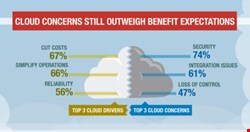
It’s a good news, bad news situation when it comes to cloud adoption. SilverSky’s Silver Lining Report found that 67% of survey respondents indicate their increasing confidence level in the cloud, while 30% have maintained the same level of confidence. Only 3% of respondents indicated a decrease in confidence in the cloud.
However, traditional back-office functions such as finance and accounting and procurement applications show no upward movement. About three-quarters (74%) of respondents harbor strong concerns around privacy and security. Although the percentage of executives that are enthusiastic about cloud services is fairly high (28%), they are outnumbered by the skeptics (39%).
Despite an overall increase in cloud confidence, three-quarters of respondents have 30% or less of their business functions/services allocated in the cloud today. Then again, a vast majority of organizations (74%) have at least one business function or service in the cloud today, and many have plans to migrate additional applications within the next year. Small businesses have migrated the most business functions to the cloud, with approximately 26% allocated so far.
The most popular cloud applications are e-commerce (41%), closely followed by email (39%) and storage (30%). Many respondents also have plans to migrate additional applications within the next 12 months, particularly storage and e-commerce (both 16%) and middleware/infrastructure (14%).
As for cloud drivers, surveyed executives are eyeing up reduction in expenditures (67%), simplification of operations (66%) and increases in the reliability of business functions (56%) as benefits. However, there’s a fair amount of uncertainty in the mix. One out of every two executives surveyed are unsure whether cloud-based services will cut internal support costs, or add to them.
When it comes to cloud vendor evaluation, survey data shows that influencers sway short lists, especially recommendations from analysts (52%) and colleagues (64%); but ultimately, personal research trumps all at 76%. Vendor commitment is also critical in the evaluation process. Once organizations decide to migrate to the cloud, they look at three primary determining factors when evaluating potential cloud partners: assurance that the vendor can commit to stringent service level agreement (SLA) guidelines (43%), assurance that the vendor can migrate their employees efficiently (41%) and assurance that third parties can vouch for the provider’s security (39%).
“Moving to the cloud should be career-defining, not career-limiting,” said Andrew Jaquith, CTO at SilverSky. “When CIOs and security decision-makers move their critical workloads to the cloud, they seek providers that cut their costs, simplify their architectures and protect their data. But equally important, they are making a leap of faith by entrusting services they can’t do without to someone they don’t know. The data in the Silver Lining Report show us why transparency, clarity and assurance are so essential.”